New Results of Some of the Conformable Models Arising in Dynamical Systems
Abstract
This article investigates the new results of three nonlinear conformable models (NLCMs). To study such varieties of new soliton structures, we perform the generalized Kudryashov (GK) method. The obtained new results are defined in the styles of the exponential and rational functions. The derived new soliton structures are stable, serviceable, and fitting to embrace the conformable dynamics, chaotic vibrations, global bifurcations, optimal control problems, fluid mechanics, plasma physics, system identification, local bifurcations, control theory and resonances, and so many. The outcomes declare that the process is hugely valuable and accessible for investigating nonlinear conformable order models treated in theoretical physics.
1. Introduction
Conformable calculus is a part of an analytical investigation that scrutinizes the actual or complicated number order integral or differential supervisors. It is a presently debated problem with scientists since many multidimensional operations could be formed through conformable derivatives in numerous disciplines of implemented science which as solid-state physics, fractional dynamics, fluid mechanics, control theory, geochemistry, plasma physics, astrophysics, system identification, chemical physics, and many more. The various appeals of conformable derivatives show that there is an essential requirement for better numerical and analytical algorithms including real objects and methods. Consequently, the examination of the soliton solutions for nonlinear conformable models expresses a critical function for the research of nonlinear wave phenomena. Numerous mathematical procedures have been presented to get results of NLCMs, for example, homotopy perturbation method [1], residual power series method [2], Shifted Jacobi spectral collocation method [3], reproducing kernel Hilbert space method [4], modified generalized Taylor fractional series method [5], the improved fractional Riccati extension scheme [6], method of separation variables [7], generalized (G′/G)-extension scheme [8], Chebyshev collocation way [9], rational (G′/G)-extension scheme [10], the first integral way [11], modified exp-task way [12], variational iteration method [13], modified Khater method [14], and iterative reproducing kernel Hilbert space approach [15].
The paper applied the GK method [16] to derive the different types of solitary wave structures for the conformable Duffing equation (DE) [8], the conformable Riccati equation (RE) [8], and the conformable biological population model (BPM) [6, 10]; in [17], it is examined time-fractional biological population model and gained some new solitary wave structures through the modified (G′/G)-expansion method.
Eq. (3) exposes numerous charming soliton structures that have not yet been confirmed. In the equations modeling wave phenomena, one of the key goals is the soliton structures, maintaining results of the constant form with a constant velocity. Soliton constructions, together with their result definitions, are in explicit or implicit ways and are pretty fantastic from the perspective of applications. Such a diversity of soliton constructions is instantly named because they do not exchange their sketches when propagation. Our attention in this investigation is to analyze the soliton constructions; the solitary waves enclosed through asymptotically zero at a substantial distance, traveling waves, the kink variety waves, and the periodic waves, which increase or run down from one asymptotic state to other states.
Here W describes the population density, S1 and S2 are free parameters, and s1(W2 − s2) expresses the population supply owing to births and deaths. The solutions obtained exhausting the mentioned procedure can be expressed in the form of trigonometric, hyperbolic, and rational type functions. These arrangements of the solutions are reasonable for revising convinced real type physical phenomena. However, there are various types of models that are useful for computing different models, for instance, ranking extreme efficient decision?, new extended rational SGEEM for construction of optical solitons?, the time nonlinear fractional generalized equal width model arising in shallow water channel?, an efficient alternating direction explicit method?, the variable coefficients generalized shallow water wave equation?, M-fractional solitary wave solutions and convergence analysis for Boussinesq equations?, the solving the Volterra integral equations with a weakly singular kernel? and an analytical analysis to solve the fractional differential equations? In the literature, these nonlinear model of equations for natural models are well used. These nonlinear models can be used alone or in combination to model physical processes relevant to engineering, technology, and sciences.
2. Glimpse of the GK Method
Step 1. Suppose a conformable PDE for W(x, t) takes the form
Step 2. Compute M and N on Eq. (8).
Step 3. We examine the following:
3. Solitons to the Conformable RDE
Through Eq. (13) and Eq. (12), we find the following:
where B0 and B1 are constants.
4. Solitons to the Conformable DE
Through Eq. (23) and Eq. (22), we have the following sets:
5. Solitons to the Conformable BPM
Let us consider the Eq. (5).
Through Eq. (29) and Eq. (28), we have the following sets:
The physical meaning of solutions is as follows: this segment will examine the physical explanation of the time-fractional biological population model of the acknowledged exact influencing wave equation. The three-dimensional (3D) charts and density plots including real and imaginary parts of the newest fractional BPM equations’ travelling wave solutions are discussed in this subsection. A three-dimensional plot depicts the extent of divergence across time or relates many wave issues. Wave facts are arranged in a logical order with equally spaced disturbances and connected by a line to show the relationships between them. The diagram’s pictorial value is enhanced by the 3D style. The density plot and 3D plot are designed to show the low and high frequency and amplitude extremely clearly.
6. Conclusion
In the current work, we have secured the exact traveling wave answers in the novel method, for instance, kink variety traveling wave answers, double soliton, multiple solitons, periodic, and singular soliton of the Eqs. (1), (4), and (5). The two models’ established answers, as mentioned above, are applicable to search the fusion and fission aspects. This natural phenomenon happens for solitons, electromagnetic interactions, scalar electrodynamics, quantum relativistic one-particle theory, relativistic energy-momentum relation, etc. The magnitude of the Eq. (1) usually rises in determining the optimal control difficulties. In the echo region, the oscillation of vibration depends on the damping exponent in a nontrivial way. So, to reduce severe fluctuation is an introductory presentation of the Eq. (4). The picture is a crucial device for information and to express the answers to the difficulties lucidly. When performing the calculation in daily life, we need a fundamental knowledge of building graphs. Subsequently, the graphical displays of a few answers are illustrated in Figures 1–10, respectively. We displayed Figures 1–10, respectively, for a few of the derived answers to reveal more features for the prescribed model. The GK method’s performance is more accessible and reliable than the other approaches to define the exact answers derived in this research. The technique can be significant for further examining distinct conformable PDEs in high energy physics, mathematical physics, quantum gravity, and numerous nonlinear physics branches. It is obvious that the technique we suggest is successful, dependable, and easy to use, and that it provides enough well-matched answers for NLFPDEs that emerge in engineering, applied mathematics, and mathematical physics.
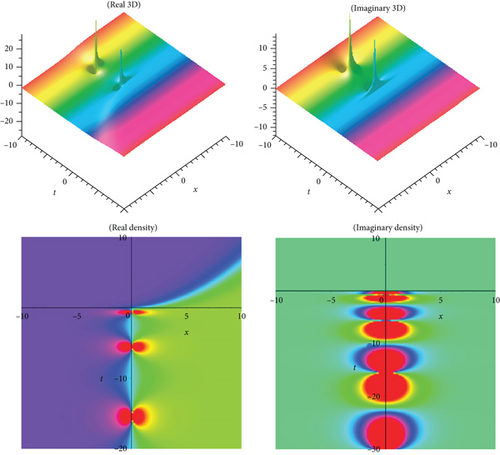
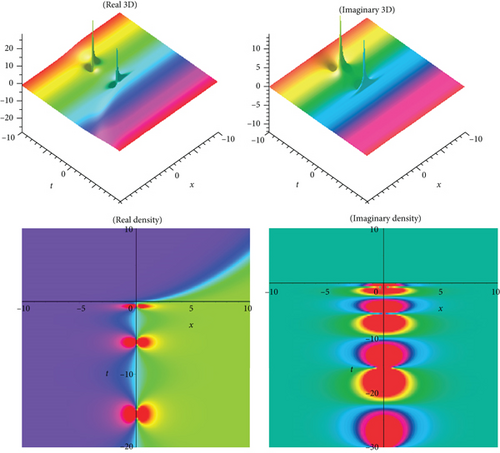
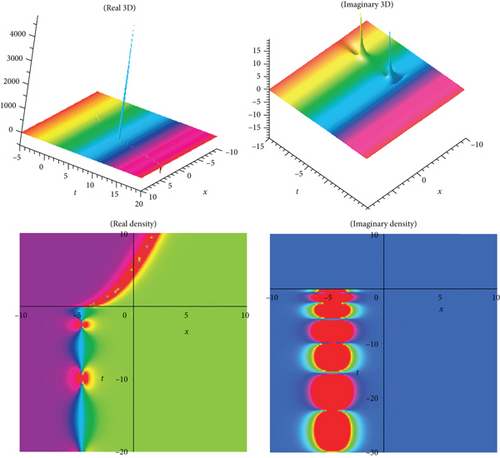
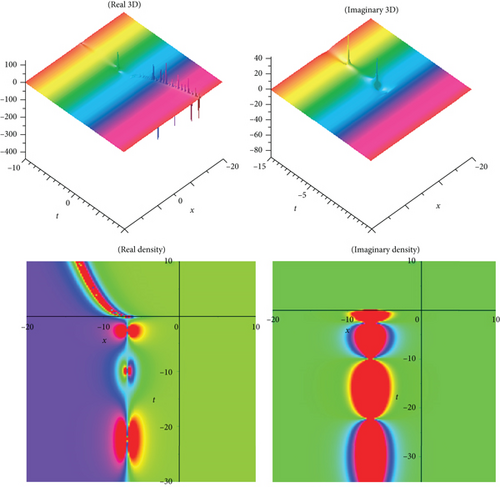

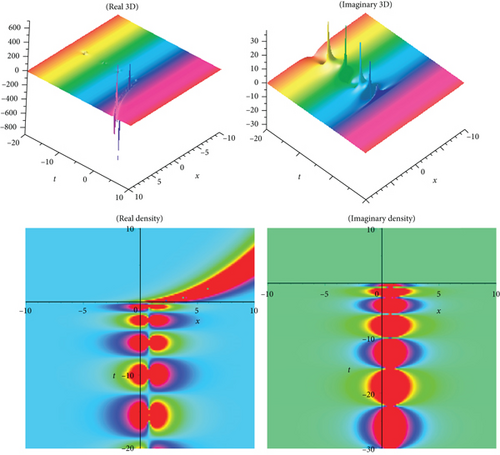
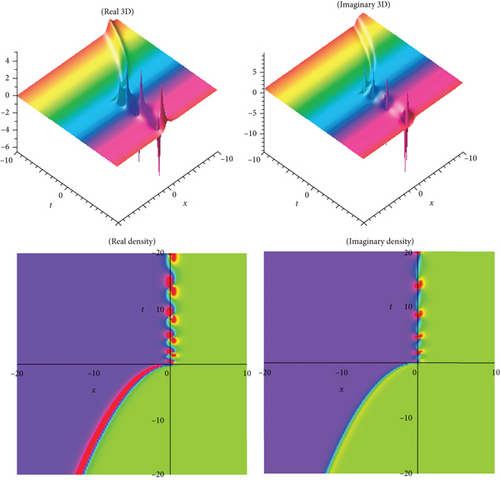
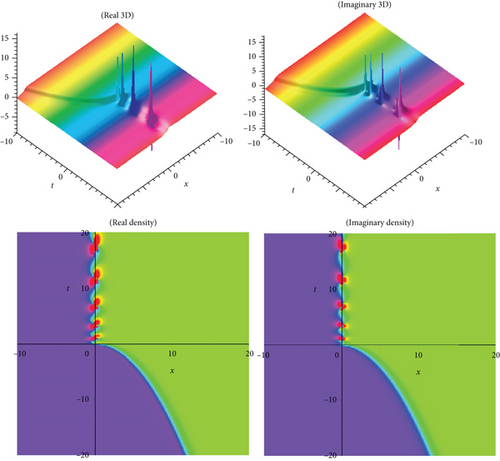


Conflicts of Interest
The authors declare that they have no conflicts of interest.
Open Research
Data Availability
The data used to support the findings of this study are included within the article.




